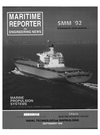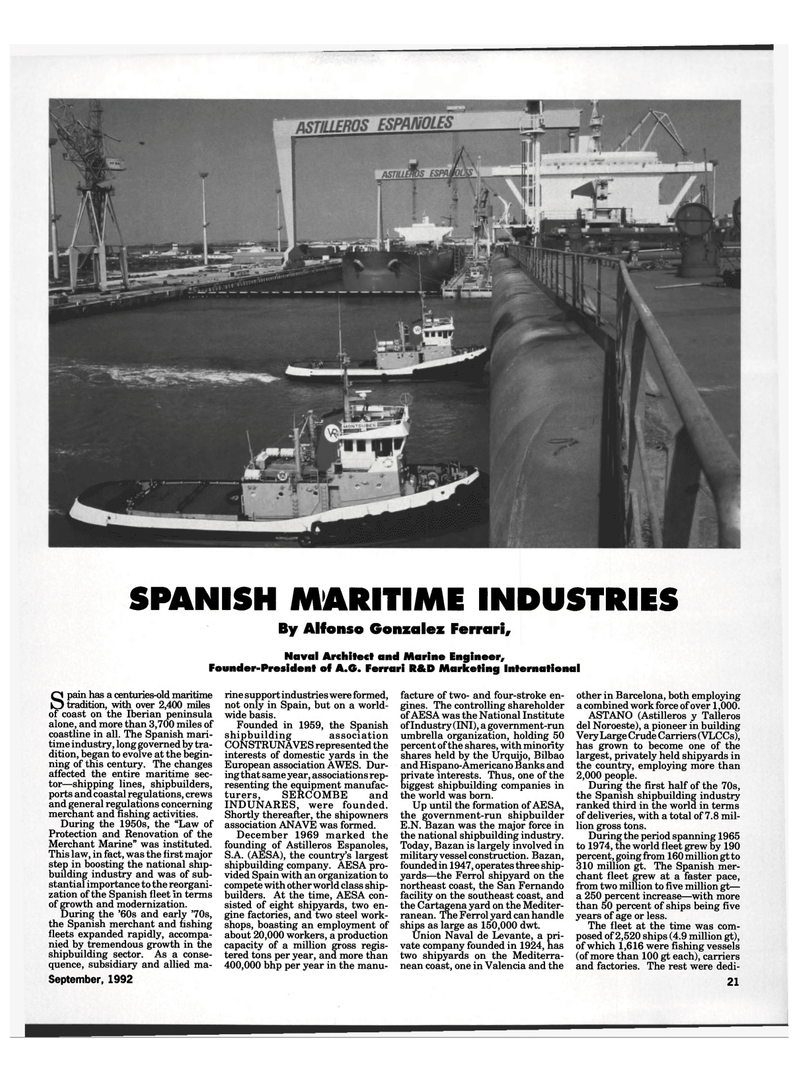
Page 19: of Maritime Reporter Magazine (September 1992)
Read this page in Pdf, Flash or Html5 edition of September 1992 Maritime Reporter Magazine
SPANISH MARITIME INDUSTRIES
By Alfonso Gonzalez Ferrari,
Naval Architect and Marine Engineer,
Founder-President of A.G. Ferrari R&D Marketing International
QJ pain has a centuries-old maritime
U tradition, with over 2,400 miles of coast on the Iberian peninsula alone, and more than 3,700 miles of coastline in all. The Spanish mari- time industry, long governed by tra- dition, began to evolve at the begin- ning of this century. The changes affected the entire maritime sec- tor—shipping lines, shipbuilders, ports and coastal regulations, crews and general regulations concerning merchant and fishing activities.
During the 1950s, the "Law of
Protection and Renovation of the
Merchant Marine" was instituted.
This law, in fact, was the first major step in boosting the national ship- building industry and was of sub- stantial importance to the reorgani- zation of the Spanish fleet in terms of growth and modernization.
During the '60s and early '70s, the Spanish merchant and fishing fleets expanded rapidly, accompa- nied by tremendous growth in the shipbuilding sector. As a conse- quence, subsidiary and allied ma-
September, 1992 rine support industries were formed, not only in Spain, but on a world- wide basis.
Founded in 1959, the Spanish shipbuilding association
CONSTRUNAVES represented the interests of domestic yards in the
European association AWES. Dur- ing that same year , associations rep- resenting the equipment manufac- turers, SERCOMBE and
INDUNARES, were founded.
Shortly thereafter, the shipowners association ANAVE was formed.
December 1969 marked the founding of Astilleros Espanoles,
S.A. (AESA), the country's largest shipbuilding company. AESA pro- vided Spain with an organization to compete with other world class ship- builders. At the time, AESA con- sisted of eight shipyards, two en- gine factories, and two steel work- shops, boasting an employment of about 20,000 workers, a production capacity of a million gross regis- tered tons per year, and more than 400,000 bhp per year in the manu- facture of two- and four-stroke en- gines. The controlling shareholder of AESA was the National Institute of Industry (INI), a government-run umbrella organization, holding 50 percent of the shares, with minority shares held by the Urquijo, Bilbao and Hispano-Americano Banks and private interests. Thus, one of the biggest shipbuilding companies in the world was born.
Up until the formation of AESA, the government-run shipbuilder
E.N. Bazan was the major force in the national shipbuilding industry.
Today, Bazan is largely involved in military vessel construction. Bazan, founded in 1947, operates three ship- yards—the Ferrol shipyard on the northeast coast, the San Fernando facility on the southeast coast, and the Cartagena yard on the Mediter- ranean. The Ferrol yard can handle ships as large as 150,000 dwt.
Union Naval de Levante, a pri- vate company founded in 1924, has two shipyards on the Mediterra- nean coast, one in Valencia and the other in Barcelona, both employing a combined work force of over 1,000.
ASTANO (Astilleros y Talleros del Noroeste), a pioneer in building
Very Large Crude Carriers (VLCCs), has grown to become one of the largest, privately held shipyards in the country, employing more than 2,000 people.
During the first half of the 70s, the Spanish shipbuilding industry ranked third in the world in terms of deliveries, with a total of 7.8 mil- lion gross tons.
During the period spanning 1965 to 1974, the world fleet grew by 190 percent, going from 160 million gt to 310 million gt. The Spanish mer- chant fleet grew at a faster pace, from two million to five million gt— a 250 percent increase—with more than 50 percent of ships being five years of age or less.
The fleet at the time was com- posed of2,520 ships (4.9 million gt), of which 1,616 were fishing vessels (of more than 100 gt each), carriers and factories. The rest were dedi- 21

 18
18

 20
20
